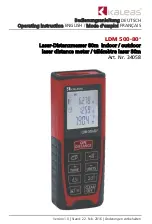
RM-26999 Calibration Procedure
2
ni.com/calibration
Terms and Definitions
DUT
DUT is an acronym for Device Under Test, and refers to the NI product being
calibrated. For this procedure, DUT refers to the RM-26999.
As-Found Limits
These limits are derived from the published specifications for the DUT. NI
uses these limits to determine if the DUT is performing within the
recommended calibration interval specifications at the time of calibration
and before any adjustment is performed.
As-Left Limits
These limits are derived from the published specifications for the DUT minus
guardband to ensure a high probability that the DUT will meet its
specifications over the next recommended calibration interval.
Functional Test
Functional Tests determine whether the DUT is operating correctly.
Functional tests are not directly related to performance specifications.
Verification
Verification evaluates the measured calibration results against the defined
As-Found Limits. The result of the evaluation is expressed as a Pass/Fail
condition in the calibration certificate using an established evaluation
formula.
Adjustment
Adjustment performs a set of operations on the DUT to optimize the
measurement performance and conform it to the assigned calibrated values.
Reverification
Reverification evaluates the measured calibration results against the As-Left
limits after adjustment. The As-Left limits may be tighter than the As-Found
limits.
Recommended
Calibration
Interval
This interval indicates the recommended period between each round of
verification and adjustment of the DUT. There is a high probability that,
within this interval, the DUT will remain within the published warranted
performance specifications. Some measurement DUTs have warranted
specifications for different calibration intervals, for example: 24 hours, 90
days, 1 year, and 2 years. In this case, the specification depends on the
calibration cycle chosen by the user.
Calibration Overview
Recommended Calibration Interval
1 year




































